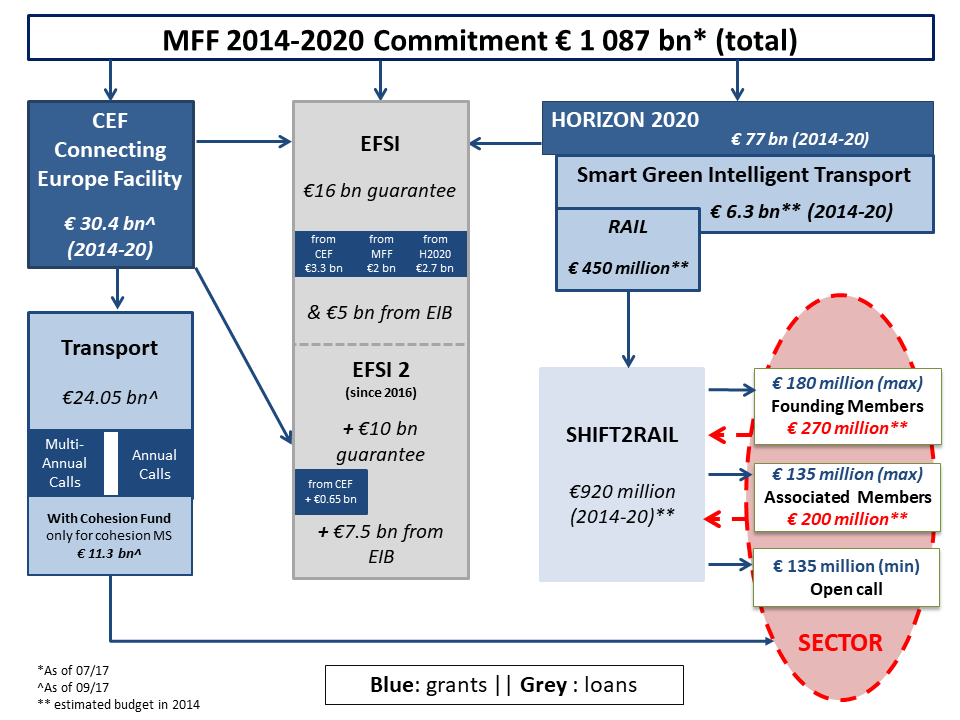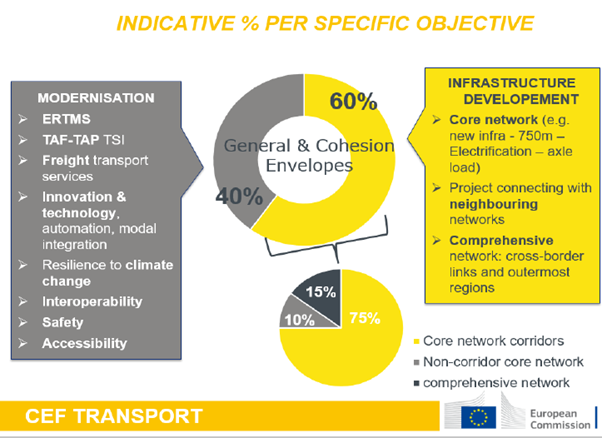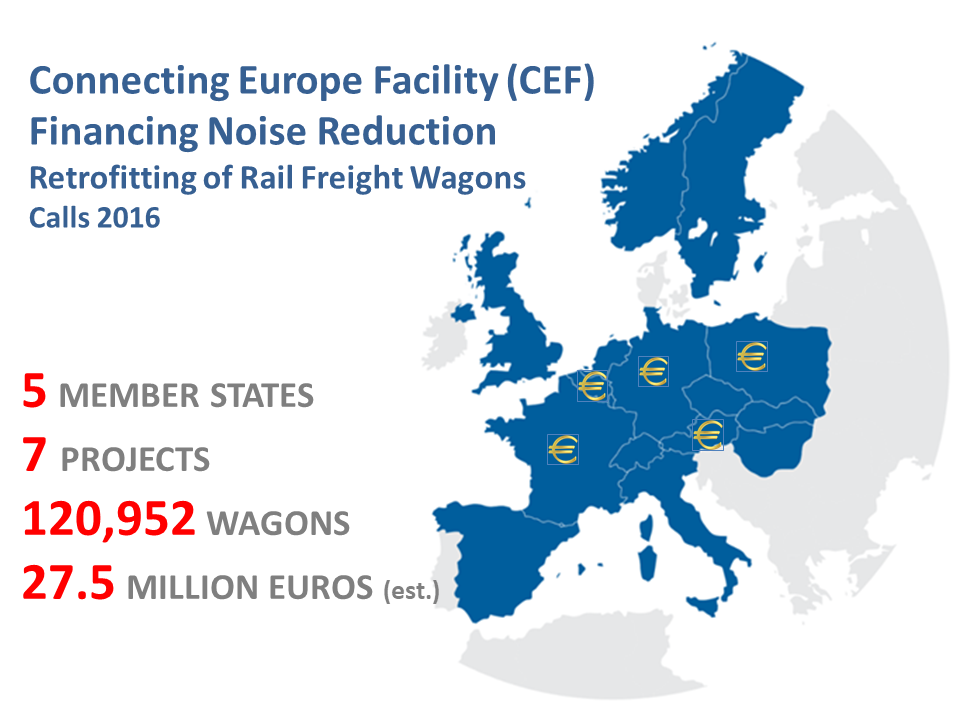The EU Multiannual Financial framework (MFF)
The EU financial framework needs stability

The Multiannual Financial Framework (MFF) for 2014-2020 is set up to support programmes that reflect the European political economic and development priorities, including:
- The Trans-European Transport network policy (TEN-T), aiming to close the gaps between Member States’ transport networks, remove bottlenecks and overcome technical barriers such as incompatible standards for railway traffic
- Transport, Energy and Infrastructure projects to be funded under the Connecting Europe Facility (CEF)
- Research and Innovation under HORIZON 2020 and the Rail Joint Technology Initiative, Shift2Rail
- Strategic investments infrastructure, education, research and innovation, as well as risk finance for small businesses under the European Fund for Strategic Investments (EFSI)
MFF also supports administrative structures such as European Union Agency for Railways and Innovation and Network Executive Agency (INEA) designed to launch application procedures, evaluate projects, and execute and monitor the realisation of the approved projects. The European Commission is due to make a proposal for the next Multi-annual Financial Framework (MFF) by the end of 2017. The proposal should reflect the future challenges and needs of the EU post-2020 and post-Brexit. The new MFF might have a new structure, financing revenues and duration.
Financial Instruments
The Connecting Europe Facility (CEF) for Transport is the funding instrument to implement European transport infrastructure policy. CEF Transport focuses on cross-border projects and projects aiming at removing bottlenecks or bridging missing links in various sections of the TEN-T Core Network and on the Comprehensive Network, as well as innovation in the transport system.
- Scope (relevant): TEN-T, Freight (incl. Last mile and TAF related calls) and Noise Retrofitting
- CEF projects by Country:https://ec.europa.eu/inea/connecting-europe-facility/cef-transport/projects-by-country
- CEF projects by Transport Mode: https://ec.europa.eu/inea/connecting-europe-facility/cef-transport/projects-by-transport-mode
The CEF Transport Blending Facility (CEF TBF)
The CEF Transport Blending Facility is an innovative approach to promote the substantial participation of private sector investors and financial institutions in projects contributing to the environmental sustainability and efficiency of the transport sector in Europe. It will support in particular the deployment of the European Railway Traffic Management System (ERTMS) and the deployment of Alternative Fuels. The European Investment Bank (EIB) will be the first Implementing Partner upon the signature of an operational agreement with the EC. Other entities, such as national promotional banks, may be entrusted in the future. The European Commission is currently negotiating agreements to define the respective involvement of other potential Implementing Partners.
With a budget of EUR 198 million, the grant component of the Blending Operations under the CEF Transport Blending Facility is managed by the Innovation and Networks Executive Agency (INEA).

Promoters can only apply for the CEF TBF grants with the support of the EIB or other implementing partners and can already now approach the EIB to discuss the funding possibilities. Implementing Partners will screen potential operations for their eligibility for a CEF TBF grant. In addition, project promoters may receive advice on financing and blending opportunities or advisory services through the EIAH by sending an email request to eiah@eib.org.
Further information can be found under https://ec.europa.eu/inea/en/connecting-europe-facility/cef-transport/apply-funding/blending-facility
FAQ for CEF Blending: https://ec.europa.eu/inea/en/connecting-europe-facility/cef-transport/2017-cef-transport-blending-call-faq
At national Level, you can also contact the so called National Contact Points who should be able to provide support on CEF and CEF Blending related matters: https://ec.europa.eu/inea/sites/inea/files/cef_transport_contact_persons_151126.pdf
European Structural and Investment Fund (ESIF)
The ESIF Financing combines several fund sources, European Regional Development Fund and Cohesion Fund being most relevant to rail. It is managed via the Regional Policy of the European Union in partnership with the Member States. It supports projects in Digital Technologies, Research and Innovation, Lower Carbon Economy, Sustainable Management of Natural Resources and Small Businesses. To find beneficiaries in your MS and regions, please visit: http://ec.europa.eu/regional_policy/en/atlas/beneficiaries/
The European Fund for Strategic Investments (EFSI)
The European Fund for Strategic Investments (EFSI) adopted on 25th June 2015 is part of the Juncker “Investment Plan for Europe” which aims to mobilise €315 billion by leveraging private investments for transport infrastructure and other strategic sectors of the European economy. The EFSI Instrument is meant to complement the Connecting Europe Facility (CEF) and the European Structural and Investment Fund (ESIF).

A revision of the EFSI, called EFSI 2, proposed in September 2016 brought the following important modifications:

EFSI – Lending Scheme
- Scope: rehabilitation, upgrading or electrification of existing lines; construction of new lines, signalling systems and intermodal terminals; financing of rolling stock for freight and passenger services, both conventional and high-speed
- Structures: blending with other initiatives such as CEF, Project Bond Initiative and Loan Guarantee Instrument.
- To see projects financed, go to http://www.eib.org/projects/loan/list/?sector=2010. You will need to folder to check through the list as it is comprehensive and covers all modes of transport.
- To get advice on the project application, go to Innovfin Advisory section http://www.eib.org/products/advising/innovfin-advisory/index.htm
- To get advise at national level on projects, finding partners from public and private sources, you can contact the European Investment Advisory Hub via http://eiah.eib.org/
- To finance a project, it is possible to combine an EFSI loan with other European funds, such as CEF and Horizon 2020. A good example is the 2017 CEF Transport Blending MAP Callwhich made EUR 1bn in CEF grants available for privately-financed transport projects, including EFSI financing.
CEF 2021-27 for Transport
Despite the new investment initiatives launched beetween 2014-2019, rail and other transport sectors are concerned about the possible further shift and reduction of funds originally dedicated to transport projects (including projects for noise reduction). In view of the next EU long-term budget 2021-2027, a Common Understanding was reached on the CEF 2021-2027 between the Council and European Parliament in March 2019 which provides for the continuation of the CEF programme focusing on cross-border links and missing links with increased emphasis on decarbonisation and digitalisation as well as a new military mobility component. The Commission proposal was for a total transport budget of EUR 30.6 billion. Novelties compared to the current CEF include a 60% climate expenditure target, increased facilitation of synergies between the three sectors and blending operations with InvestEU.

Significance to UIP and our Members
There is political pressure to increase rail freight transportation and reduce environmental pollution such as noise. By understanding the EU financial programme, its framework and where the EU budget is prioritised, our members can more easily consider strategies to participate in relevant to them EU projects and receive financial support through dedicated EU financial resources. A CEF call for noise related projects and telematics applications was launched in autumn 2016. A total estimate of €27.5 million are currently negotiated for seven“noise retrofitting” projects representing about 121,000 wagons.

On 17th May 2018, DG Move launched a new CEF call which entailed, among others, a project with an indicative funding of €100 million for Rail interoperability and ERTMS. With this call, the European Commission confirmed its strong support for the introduction of predictive and condition-based maintenance. As this was also a priority for wagon keepers and in order to facilitate the application process for interested companies, UIP published dedicated guidelines for this call to support the submission of projects aimed at capturing data by installing sensors and telematic devices on freight wagons. All in all, wagon keepers submitted proposals to the 2018 call and eight projects on rail interoperability with an overall amount of €48 million were retained and will be co-funded. Find out more about the CEF Transport projects that have been funded each year under https://ec.europa.eu/inea/connecting-europe-facility/cef-transport/projects-by-year.
On 8th January 2019 a new CEF call opened with an indicative funding of €35 million for reducing rail freight noise by retrofitting existing freight wagons with composite brake blocks, and where necessary due to extreme weather conditions with disc brakes, including by retrofitting of existing rolling stock (submission deadline was 24th April 2019). One of the achievements UIP had advocated for was that for the first time the CEF contribution took the form of unit contribution which simplified the application process and ensures certainty and transparency in the funding levels. In addition, reporting requirements had been reduced as no certification or financial statement needed to be provided by the beneficiaries and no Cost-Benefit Analysis (CBA) was needed. UIP members built two consortia in order to reach the minimum threshold of 2,000 wagons and participated in the call.
However, since 2017, three years before its term, the budget for the Connecting Europe Facility (CEF) for Transport has been used and the demand for CEF funds exceeds 2.5 times the available resources. Therefore, if the CEF Transport budget does not increase in 2021-2027, the completion of the core network is at risk due to insufficient budget. Consequently, under the More EU Budget for Transport Coalition, UIP and more than 40 European associations representing transport, infrastructure managers, operators, contractors, local and regional authorities, logistics service providers, shippers, users and equipment suppliers in the maritime, inland waterways, railways, road, cycling, aviation and intermodal sectors, called upon European policy makers to:
- Increase the EU budget for the Connecting Europe Facility
- Invest in better and more innovative transport
- Continue providing grants as the conventional tool for funding transport projects on the TEN-T core and comprehensive networks

